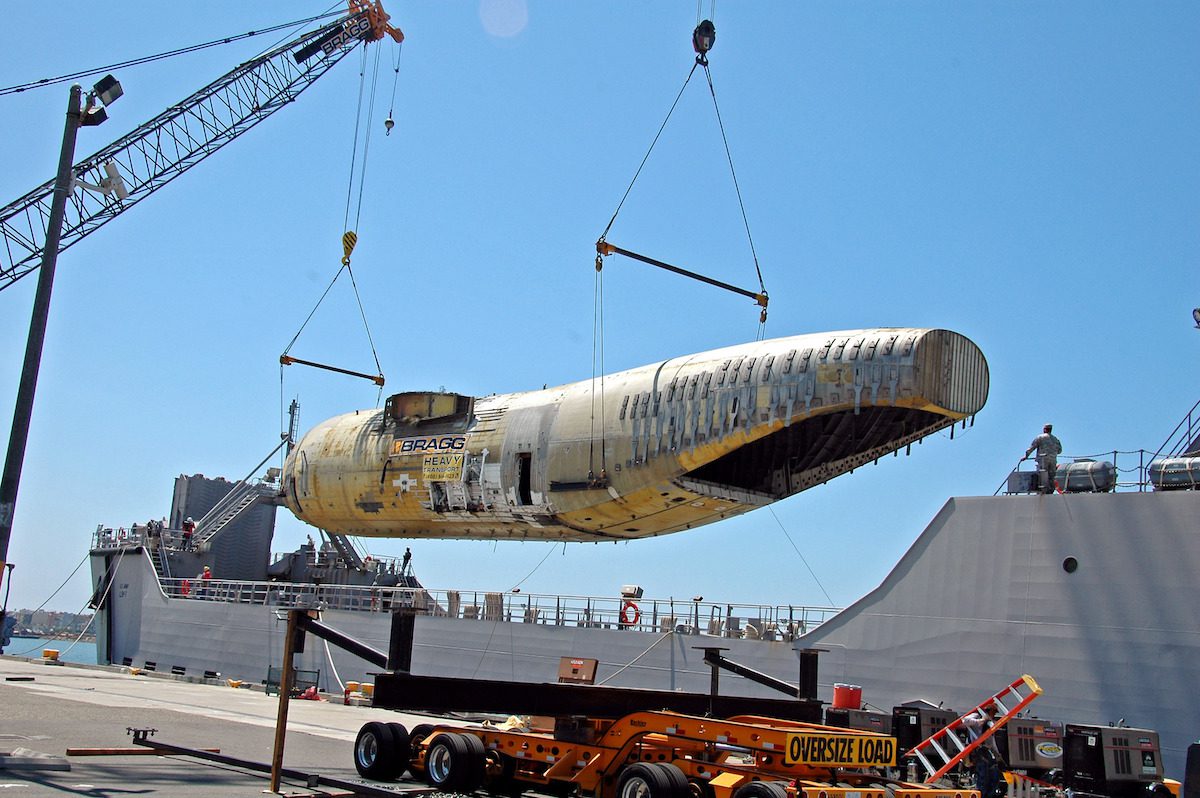The fuselage of a giant C-17 cargo aircraft is lifted onto the Army transport ship SSGT Robert T. Kuroda (LSV-7) at the Seal Beach Naval Weapons Station, July 22, 2009. U.S. Navy Photo
By Michael Carr – A Boeing C-17 cargo aircraft is a big aircraft, with a wingspan of 169 ft., and length of 174 ft. Her fuselage width is 20 ft. and height is over 12 ft. One hundred and two fully equipped Army paratroopers can fit inside the cargo area. Hundreds of these aircraft were built for military use, and are flown worldwide every day.
Chief Warrant Officer John Owens sat in his cramped office on Hickam Air Force Base in Hawaii making cold calls on his phone. His office was piled with boxes, supplies, reports, spare parts, and a dozen empty or partially empty, coffee cups.
“I need you for a mission,” he was repeating over and over as he went down his list of Army Mariners qualified to sail on the LSV-7, the Army’s newest Logistic Support Vessel (LSV).
“It’s going to take a couple of months, and I can only use you if you are 100% available”.
“We are hauling a C-17 aircraft fuselage from California to Ft Eustis VA. Boeing is giving the Army a fuselage for loadmaster training, and we need to get it from the Boeing plant in California to Ft Eustis in Va. That’s our mission.
“Say what?” And then all those questions, “Has anyone measured this thing? Will it fit on deck?”
“Yes, it will fit, our open deck area is 200 ft. long and the fuselage is 174 ft. long. It will fit…I think”.
Within a few weeks Chief Owens had his crew assembled and LSV 7 sailed from Pearl Harbor Hawaii to the US Navy port in Seal Beach CA, where Boeing had trucked the C-17 fuselage.
“Are you sure this thing will fit on deck?” I asked John as we sat alongside the dock. I was serving as the LSV Chief Mate and Chief Owens was the Chief Engineer. We had both gone over the engineering details and measurements many times, but as we sat dockside & looked over at the fuselage it looked too large to fit on our deck.
“It’s just an optical allusion,” I said. “It looks big, but it will shrink once the crane raises it up.” John rolled his eyes and moved a few feet away from me.
Placing the fuselage on deck first required welding pad eyes and support gussets onto the LSV’s deck. We double-checked the location of fuel tanks, voids, and ballast tanks to ensure the deck welding was in areas where there were no issues.
After several days of welding and rigging the C-17 fuselage was raised by two cranes and loaded onto our deck. Slowly the massive fuselage settled onto the supports welded to the LSV’s deck. Once the fuselage was locked into place, we went around with cans of yellow spray paint and covered every critical weld and bolt. This way we could check the fittings on each watch and catch any movement or cracks.
“How are we going to declare this cargo when we transit the Panama Canal?” we both asked? Since duty must be paid on all cargo we had no idea how this fuselage would be categorized. Somehow we made it through the canal without incident and steamed up through the Yucatan Straits.
Avoiding rolling and pounding seas was a constant concern, we did not want to wrack or bend the fuselage due to heavy wind or seas, so we looked for the smoothest ride. Every day we talked with US Navy weather routers in San Diego and Norfolk VA. “Route us for wind and seas abaft our beam!” was our mantra.
Through the Florida Straits and past Cape Hatteras we sailed, finally coming through the Virginia Capes and then up the James River to Ft Eustis. We felt relaxed as we headed up the James River, the stress of potential storms and seas were over, and the C-17 fuselage was intact and undamaged.
We made our final radio call after 2 months at sea; “US Army Port Control, this is LSV 7, request permission to enter port.” And back came a welcome response, “LSV 7 this is Port Control, permission granted, welcome to Ft Eustis.”
We slowly entered the Army’s port at Ft Eustis and moored starboard side to on the main bulkhead. “Put over all lines, shift colors, and set the in-port watch” came the pipe on LSV-7’s public address system.
I looked at Chief Owens, and around the bridge, we had accomplished a great feat, sailing a C-17 fuselage thousands of miles at sea, and bringing it safely to its destination. I went out on the starboard bridge wing with my coffee cup and leaned against the outboard coaming. I was in no rush to leave the bridge or go anywhere.
I drank my coffee and watched our crew adjust mooring lines and fenders, set up the gangway, and talk to Soldiers standing on the dock. I took in the smell of mud at low tide, diesel fuel, saltwater, and those other aromas you only find in harbors & ports.
“I’m going down to the wardroom to see what’s going on now, you want to come along?” asked Chief Owens.
“No thanks” I answered, “I am going to hang out here for a while longer.”

 Join The Club
Join The Club











